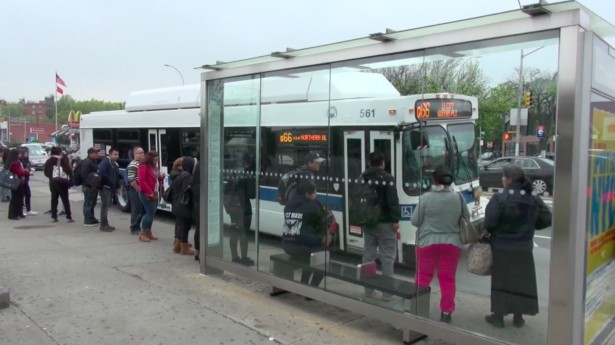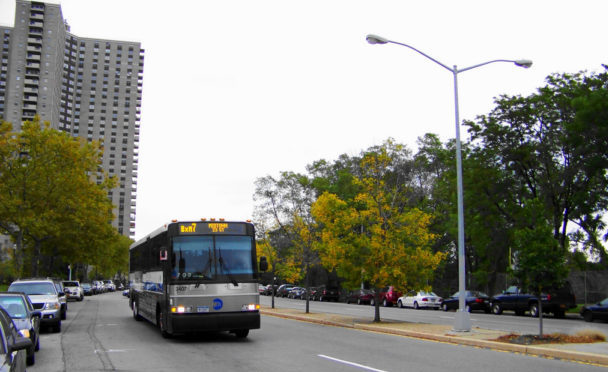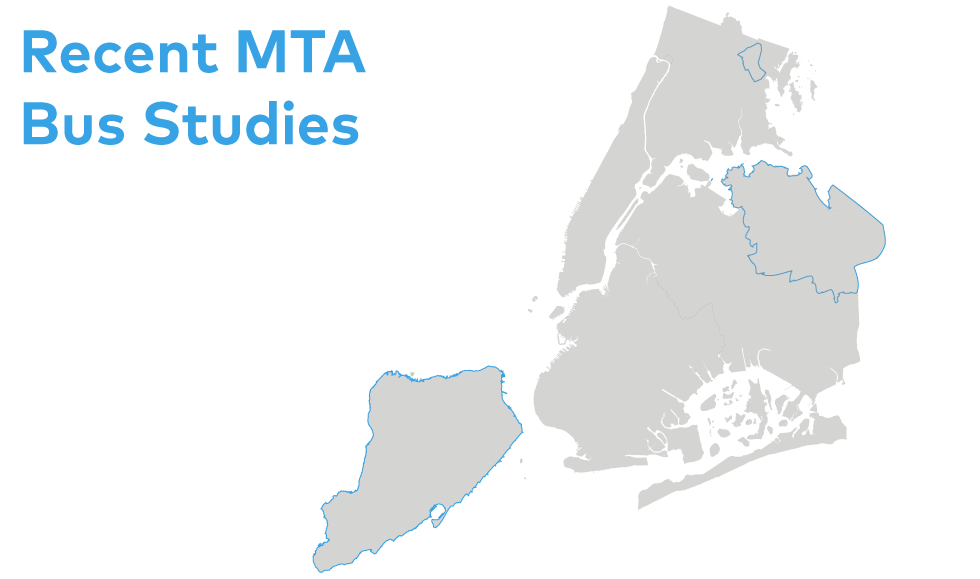

Bus in Co-Op City. Photo Credit: Emmanuel Nicolas. Used with Creative Commons License
MTA responses to the July launch of the Turnaround: How to Fix NYC’s Buses report by a coalition of pro-transit groups asserted that “many of the recommendations in the report are actions the MTA is already taking.” The MTA referred reporters to bus studies of Co-op City (2014) and northeastern Queens (2015) and an ongoing study in Staten Island as examples. But given the gravity and scope of bus service and ridership decline in NYC, these limited studies and the actual changes resulting from them fall far short of the citywide effort that will be needed to fix New York’s ailing bus system.
Though we hope the MTA will announce at the NYC City Council’s hearing on bus service this week that it is developing systemic and pro-active steps to reverse the decline of NYC buses, it is possible the MTA will reprise this argument.
As Turnaround details, New York City’s buses are slow and unreliable, and these problems are worsening. Despite population and job growth, bus ridership is dropping in Manhattan, Brooklyn and Queens. Ridership is steadier in the Bronx and Staten Island, but has not kept pace with increases in employment and population.
[table “” not found /]
Ridership figures are from the MTA: http://web.mta.info/nyct/facts/ridership/ridership_bus.html
Population numbers are from the NYC Department of City Planning: http://www1.nyc.gov/site/planning/data-maps/nyc-population/current-future-populations.page
Job growth statistics are from the New York State Department of Labor: https://www.labor.ny.gov/stats/nyc/
Ridership decline is a trend we should take seriously. It can mean more would-be riders traveling in single-occupancy vehicles, less mobility for individuals foregoing trips and a downward spiral where lower usage lead to service cuts, which further repel riders. Reversing the bus system’s decline is urgent: but it will require MTA leadership to admit that buses in New York are beset with problems, and to deploy concerted policy attention to solve them.

The studies the MTA has held up cover a relatively small part of New York. That would not be a concern if these studies were steps in a comprehensive, citywide policy to revive bus service. Instead, they appear to be one-off efforts triggered by local elected officials responding to complaints by riders. Worst of all, the changes recommended in the studies are minimal, and fall far short of what’s needed to improve the performance of our buses.
The changes recommended in the Co-op City and northeastern Queens studies included some highlighted in Turnaround. Straightening indirect routes and adding service on routes with growing ridership are examples. However, many needed strategies were left out, including right-sizing the distance between bus stops and giving buses priority at traffic signals. The northeast Queens study recommended short term changes on about one-third of the 27 local routes operating in the area.
Of the hundreds of route-miles in Queens, MTA’s report proposed only these minor short term changes:
- Modify the Q65 travel path in Flushing to provide more reliable service and all‐day service on Parsons Boulevard alongside the part‐time Q26;
- Continue to schedule additional trips such as those on the Q12, Q13, Q28, and Q58 that were added for Summer 2015 as part of ongoing schedule changes
- In conjunction with the initiation of Q44 SBS, create 24‐hour service on the Q20A
- Analyze the feasibility of overnight and all‐day service on the Q13, Q30, and Q88
- Continue to adjust running time on all routes to improve schedule adherence
Source: MTA. September 2015. Northeast Queens Bus Study: http://www.mta.info/sites/default/files/northeast_queens_bus_study_-_final_9-28-15.pdf
The latter point is not a service improvement. At a time when buses speeds and reliability are dropping, revising the schedule typically means matching it to reflect the longer trip times riders are experiencing.
The northeastern Queens study lists long term recommendations to “explore,” “analyze,” or “study.” With review of bus routes and performance so limited and infrequent, it’s unclear when an opportunity for action will come.
The list of recommendations from the Co-op City study, which was conducted to defend changes made during the MTA’s 2010 service cuts, is similar in nature. Additional trips were added to meet growing ridership and a few new bus stops were added. Reliability analysis indicates Co-op city routes did not meet NYC Transit’s On Time Performance assessment 25% of the time, meaning that buses were either more than 5 minutes late or more than 1 minute early. Despite this, additional proactive measures to improve bus speeds, shorten trip times and improve reliability, like dedicated lanes and transit signal priority, or right-sizing the space between bus stops, were not recommended by the study.
The ongoing study of all bus routes on Staten Island has the potential to be more significant in scope, and Borough President James Oddo has repeatedly called for bold changes. It nonetheless remains to be seen if it will include a comprehensive reconsideration of local and express routes and how energetically any recommendations will translate into real change.
Other key changes for city buses require a leadership mandate beyond the scope of local studies. One example is comprehensive planning to ensure service reaches the travel destinations of today’s riders, including adding routes in areas of new demand. Implementing better methods of keeping buses on schedule requires intervention in basic practice for dispatching and monitoring buses. While NYC buses are now equipped with technology allowing dispatchers to know where buses are, analysis of Bus Time data reveals regular issues with buses not beginning their runs on time and continuing bunching problems.
Some changes to NYC buses been pursued outside of area studies, like the upcoming split of the M5 into two shorter routes in Manhattan. The breaking up of overly long routes, which tend to be less reliable, is commendable, but at one per year it would take decades to break up all of the system’s overly long routes. Additional examples of small proactive changes recently initiated by the MTA include the re-routing of the Bx10 onto Paul Avenue from Golden Avenue to avoid the frequently congested block in front of Bronx Science and the recent re-routing of the B36 in Brooklyn, which eliminated a deviation that previously hampered the reliability of the route.
Neither the limited geographic studies prompted at the local level, nor the small corrections we’re seeing outside of those studies are sufficient given the magnitude of our bus system’s decline. To see the changes our buses desperately need, leaders must call for comprehensive, policy-oriented citywide reform and support the MTA in taking bigger and bolder steps to get New Yorkers back on the bus.
 On the Brink: Will WMATA’s Progress Be Erased by 2024?
On the Brink: Will WMATA’s Progress Be Erased by 2024?
The experience of being a WMATA rider has substantially improved over the last 18 months, thanks to changes the agency has made like adding off-peak service and simplifying fares. Things are about to get even better with the launch of all-door boarding later this fall, overnight bus service on some lines starting in December, and an ambitious plan to redesign the Metrobus network. But all of this could go away by July 1, 2024.
Read More Built to Win: Riders Alliance Campaign Secures Funding for More Frequent Subway Service
Built to Win: Riders Alliance Campaign Secures Funding for More Frequent Subway Service
Thanks to Riders' Alliance successful #6MinuteService campaign, New York City subway riders will enjoy more frequent service on nights and weekends, starting this summer. In this post, we chronicle the group's winning strategies and tactics.
Read More